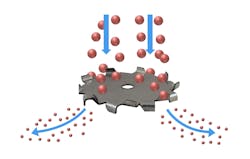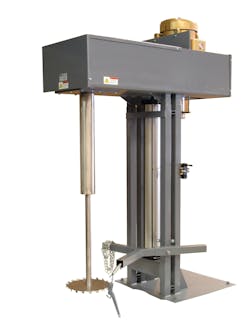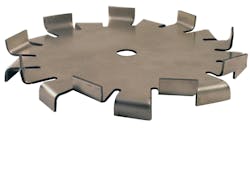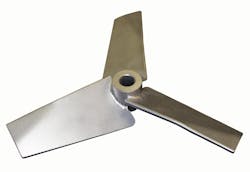Understanding the difference between high shear and low shear in industrial mixing applications

Industrial mixing is a crucial process in various industries, including production of a variety of liquid products such as foods, pharmaceuticals, cosmetics and chemicals. Mixing is also integral to continuous process industries such as wastewater treatment, fuel and energy production and mining of metals and minerals. The goal of mixing processes can be to combine ingredients, dissolve or suspend solids, or emulsify liquids to create a uniform mixture. However, different applications call for varying levels of mixing intensity, which is where the terms high shear and low shear come into play.
Industrial mixers provide the energy input necessary to generate the desired outcome for a given liquid mixing, dispersion or homogenization application. All mixing process equipment generates flow and shear, i.e. overall volumetric circulation in the vessel and shear stress, the localized turbulent interaction between particles at the trailing edge of a mixing impeller or high shear blade. By choosing the appropriate mixing impeller or high shear dispersion blade design and the rotational speed of the mixer, one can define the proportions of input energy that are converted to flow and shear.
High shear mixing utilizes intense energy to break down particles, emulsify liquids, and create a homogeneous product. This type of mixing is typically used in applications where ingredients have different viscosities, densities, or particle sizes. A form of high shear mixing, referred to as dispersion, is characterized by the use of sawtooth type flat blades turning at high rotational speeds, with high torque, and requiring significant power consumption as compared to flow-based agitation. Batch sizes are usually small, typically less than 500 gallons due to high equipment costs for large applications. Examples of high shear mixing include emulsifying sauces and dressings, dispersing pigments and colorants in coatings and homogenizing pharmaceutical creams and ointments. To use a common analogy to a home kitchen, high shear mixing is similar to the action from a blender whereas low shear mixing would be more equivalent to a countertop mixer used for folding in cake batter ingredients.
The simultaneous need for high speed and high torque requires larger horsepower motors as compared to lower shear mixing processes. To achieve high shear dispersion, a minimum blade tip speed of 2,500 feet per minute is commonly recommended. The tip speed is a function of the blade’s diameter and its rotational speed and is calculated as follows:
Tip speed (ft./min) = RPM x blade diameter (in inches) x .262
A common mistake is attempting to use a dispersion blade on an undersized direct drive mixer motor, resulting in overheating and potential failure of the motor. A blade diameter measuring one third of the mixing vessel diameter is recommended to achieve high shear dispersion while also producing enough flow in the vessel to achieve the desired process outcome. For example, a system nominally designed for a 100-gallon batch might consist of a vessel inside diameter of 30 inches, a blade diameter of 10 inches, and require a 10-horsepower drive motor. Increasing the tip speed of any impeller type will increase the shear imparted to the liquid. However, if the impeller is designed primarily to produce high flow, the result will be that the proportion of the additional energy converted to shear versus flow will remain low.
High power input and intense action via sharp blade profiles are not the answer to all mixing applications. Going back to the kitchen analogy, a blender may be great for making a smoothie, but what would it do to cake batter? The answer is that high shear would likely destroy the desired texture and consistency by making the batter too “thin.” While this is a simplistic example, there are many formulations, from condiments and sauces to industrial coatings, that share shear-sensitive characteristics.
Low shear mixing involves gentler action to blend ingredients with minimal degradation of material properties. This type of mixing is typically used in applications where ingredients are similar in viscosity and density or with solids that readily dissolve or are successfully suspended over time from gentle motion. Low shear mixing is sometimes described as flow-based mixing and is characterized by lower rotational speeds with larger diameter impeller designs and higher surface areas without sharp edges. The hydrofoil mixing impeller is a common selection for efficiently converting input energy into flow in a mixing tank with minimal shear. To move more viscous formulations, the axial flow turbine with larger impellers is often used. The larger impeller surface areas effectively contact more of the flow-resistant fluids and create greater movement in the mixing vessel, and the movement tends to be more laminar and less turbulent. Examples of low shear mixing applications include bulk blending of beverage ingredients and gently circulating flocculants in wastewater applications to allow solids to agglomerate and settle.
Low shear mixers typically feature motors paired with gear reducers, resulting in much slower rotation than direct drive mixers. This arrangement also provides higher torque for those applications involving greater densities and requiring more force in the tank to circulate the material. For example, glycerin is a common base for many formulations and is 26% more dense than water. This additional weight per unit volume must be accounted for in the mixer’s gear-drive capability to deliver the additional torque necessary to move the heavier liquid.
In conclusion, high shear and low shear industrial mixing applications require different levels of energy, rotational speed, and mixing intensity. Understanding the differences between these applications and selecting the appropriate mixer features, impellers or high shear blade types is crucial for achieving optimal batch or process results. By recognizing the specific requirements of each application, liquid product manufacturers can ensure the production of high-quality products with consistent homogeneity, textures, colors, and overall composition.
About the Author

Mark Hennis
President of INDCO
Mark Hennis is the President of INDCO, Inc., a manufacturer of industrial mixing equipment located in New Albany, Indiana. He holds a B.S. in mechanical engineering from the University of Tennessee. Since 1975, INDCO has designed and manufactured a complete lineup of mixers for batch sizes up to 50,000 gallons. More information is available at www.INDCO.com, by calling (800) 851-1049, or via email at [email protected].


